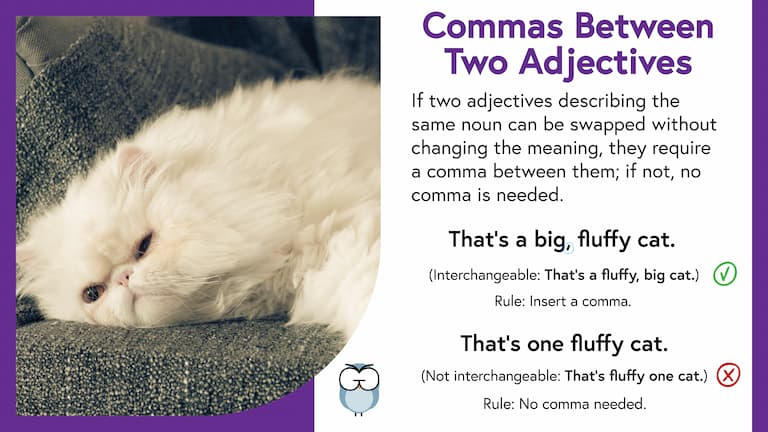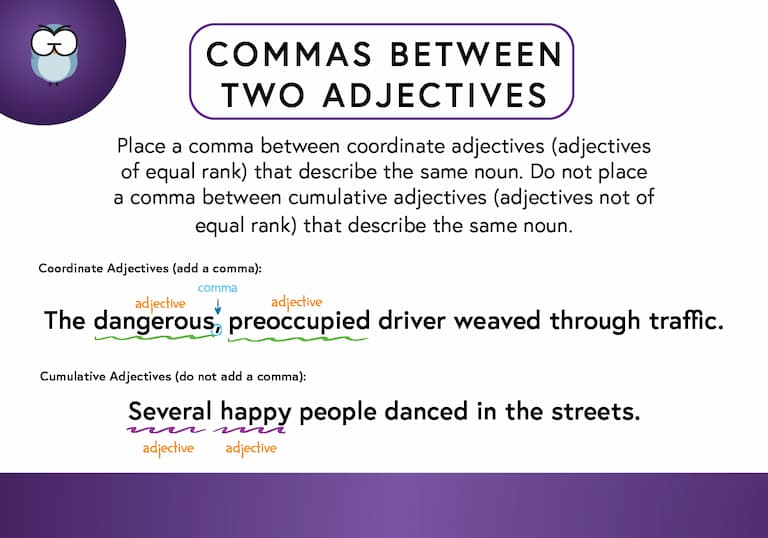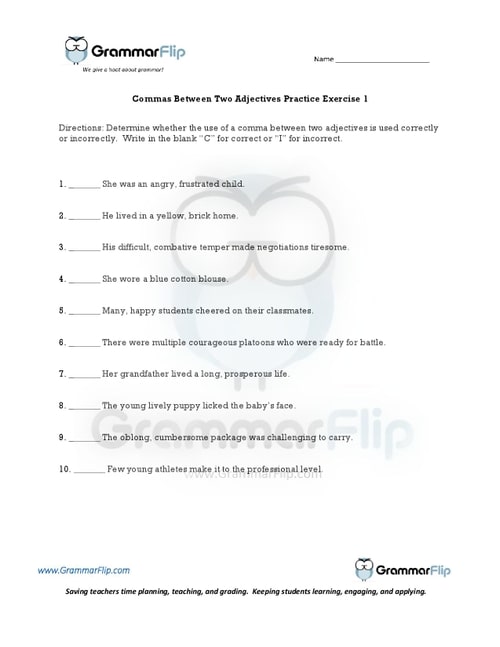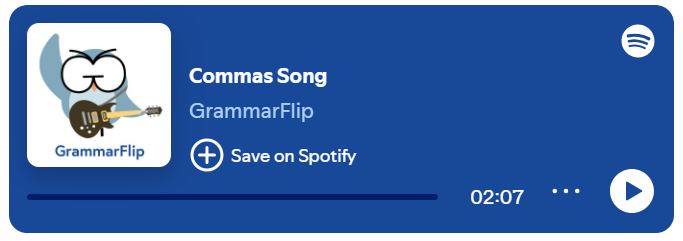When Should You Use a Comma Between Two Adjectives?
A comma should be placed between two adjectives (of equal rank) that describe the same noun. Adjectives “of equal rank” are adjectives that can exchange locations in the sentence with one another such that the sentence will still make sense. Adjectives (describing the same noun) which do not have equal rank do not require a comma.
The following are examples of adjectives of equal rank describing the same noun (note the use of a comma as well as the ability to exchange their locations in the sentence with one another):
The sad, bedraggled traveler could not believe her flight was canceled.
The dangerous, preoccupied driver weaved through the city streets viewing his phone.
The following are examples of adjectives of unequal rank describing the same noun (note the lack of a comma as well as the inability to exchange their locations in the sentence with one another):
Several happy people danced in the streets upon hearing the news.
We examined the many unique pieces of art work hanging on the walls.
Long-Form Videos: Commas Between Two Adjectives
Long-form instructional video lessons allow students to engage with grammar concepts in more depth and detail.
This format provides students with a stronger foundation and a more comprehensive understanding of commas between two adjectives.
Short-Form Videos: Commas Between Two Adjectives
Short-form videos are an excellent way to review grammar concepts. Our two-minute instructional videos help students review the concept of commas between two adjectives to further solidify their understanding.
Memorable Images: Commas Between Two Adjectives

The use of images to connect visual cues with concepts makes it simpler for students to grasp and remember key ideas. GrammarFlip’s memorable images create visual associations that make commas between two adjectives more engaging and easier to retain.
Definition Cards: Commas Between Two Adjectives
Definition cards reinforce grammar concepts by providing clear and concise explanations that students can easily reference for quick review and better retention. GrammarFlip’s definintion cards help students review the concept of commas between two adjectives to further solidify their understanding.

Music: Commas Between Two Adjectives
Learn grammar concepts through music! The unique verses and catchy chorus in our “Commas Song” will help your students further understand commas between two adjectives. Listen for yourself and see if you don’t walk away singing this song to yourself!
Listen to GrammarFlip Music via Spotify, Apple, or Amazon!
Music Videos: Commas Between Two Adjectives
Music videos make grammar concepts more engaging and memorable by combining rhythm, visuals, and repetition to reinforce learning. GrammarFlip’s music videos help students retain the concept of commas between two adjectives more effectively while making the learning process fun and interactive.
When You Should Use Commas Between to Adjectives in Your Writing
Be sure to use a comma between two adjectives when the adjectives are of equal rank which are also known as “coordinate adjectives.” Coordinate adjectives are adjectives that independently modify the same noun and are equal in importance. The following are some tests to help you know when to use a comma between two adjectives and when not to use a comma between two adjectives.
The “And” Test
Try placing the word “and” between the two adjectives. If it doesn’t change the meaning and it still sounds natural, you should use a comma.
She wore a bright, colorful hat.
She wore a bright and colorful hat. (This makes sense, so a comma is correct.)
The “Order” Test
Try reversing the order of the adjectives. If it doesn’t change the meaning, you should use a comma.
It was a long, tiring trip.
It was a tiring, long trip. (This still makes sense, so a comma is correct.)
When Not to Use a Comma
A commas is not needed when you have adjectives of unequal rank which are also known as “cumulative adjectives.” Cumulative adjectives occur when the two adjectives build upon each other to modify the noun they’re describing. This means they are not independently describing the noun, so you should not use a comma between the two adjectives.
She has three small kittens.
Notice how “three” modifies “small kittens,” and “small” modifies “kittens.” The adjectives aren’t equal in importance; instead, they work cumulatively to describe the noun, so no comma is needed.
He carried a tiny blue notebook.
Notice how “tiny” modifies “blue notebook,” and “blue” modifies “notebook.” The adjectives aren’t equal in importance; instead, they work cumulatively to describe the noun, so no comma is needed.
Keep in mind that there are several other times you’ll need to use commas in your writing such as commas with items in a series, commas after introductory clauses, and commas with essential and non-essential elements. Also, be sure to avoid comma splices in your writing.
Download a Free Worksheet on Commas Between Two Adjectives!
Click the image below to download your free worksheet on commas between two adjectives!

Need a grammar program that provides the instruction and grading for you?
Explore More GrammarFlip Lessons!
Parts of Speech lessons provide the building blocks of grammar. GrammarFlip covers these topics in detail to ensure a solid foundation is built. First time learners and students seeking to review the parts of speech can both benefit from the instructional videos and slide show reviews.
Parts of the Sentence lessons are critical for understanding how the parts of speech function in language construction. From the basic to the advanced, these lessons will cover a wide range of grammar topics that can be used in any grade level or classroom.
Mechanics and Usage lessons equip students with the necessary skills to communicate clearly to all audiences. With a focus on the application of these concepts in student writing, these lessons tie together both simple constructions of grammar as well as the more complex such that any age or skill level of student will benefit.



